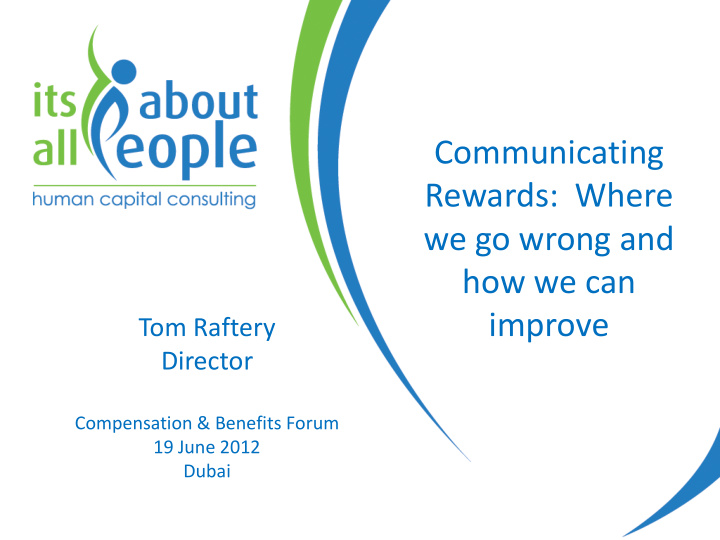



Communicating Rewards: Where we go wrong and how we can improve Tom Raftery Director Compensation & Benefits Forum 19 June 2012 Dubai
What are you communicating about your reward system?
Problem of communicating rewards Employees are unsure about their pay & benefits Pay seen as inequitable\not commensurate with performance Employees feel pay should be fair: in relation to their personal contribution to what others are being paid in the organisation to what other organisations are paying for the same job Understand expectancy theory of motivation: what employees expect to get which will motivate them rather than what they already have
Communicating reward in the Middle East Secrecy tends to prevail......but Everyone seems to know what everyone else is earning!!!! Basic policy information may be provided Progressive companies do provide information on grading structures Communication of bonus schemes often vague For managers, pay is often the only solution
Manage employees expectation Role\job size Market pay $ Performance Ability to pay
Communication and reward survey Reward communication is important, it affects: company performance motivation employee satisfaction retention Most employees have a limited understanding of reward Don’t understand how pay ranges, average pay rates and performance targets affect them Companies are not very effective at communicating reward information Reward Communication & Pay secrecy. World at Work 2008
Problems with implementation & communication Lack of support from senior management & HR!!! Lack of measures or their validity Communication limited to memos\general meetings Poor project management timing is reward a ‘lead’ or ‘lag’ system? communication planning!!!! dealing with questions and issues technology platform duration of system pilot or full roll out Measuring results & making adjustments
“Its better to implement a poorly designed reward system well, than to implement a well designed reward system poorly”
Example of good implementation – Production section bonus scheme From a group to a section specific scheme Had validated targets & measures Used visual management Tested the scheme Challenge of multiple complex measures e.g. Maximum bonus 3 months pay Average group bonus from 0.8 months to 1.7 months Production yield and cost per ton best in the Group
Problems with implementing new reward systems
Section bonus scheme – reasons for success Good design Support of production managers and superintendents Self funding Used to the measures Project planning and roll out Communication: briefed all managers and superintendents briefed all supervisors briefed all employees, in own language used posters targets and progress on section boards – weekly showed bonus achieved – monthly
Training managers in our reward systems Recognised that managers need to be trained Decisions & discussions on pay with managers difficult Understand and contribute to pay decisions Developed a handbook for managers But.................. Senior HR team wanted to delay launch concerned about questions and problems raised!!! HR don’t have resources \knowledge will cause problems with Trade Unions All jobs evaluated but could not communicate Managers were already quoting grades for jobs
Successful implementation – Communication Planning Training developed by Mercer – Managers and HR Communication planning: defined the various audiences; their needs and issues obtained buy in from the various key stakeholders agreed the core messages developed detailed Q & As identified the media channels to use by audience developed a timeline of communication to all audiences identified who would communicate and when integrated into a project plan for the launch Pilots to be run to test and adjust training Communication Planning is critical
Communication plan
Summary Gain buy-in of key stakeholders Recognise needs of various audiences Plan communication down to the last detail Use all media – social media Communicate, communicate & then you know what you do? COMMUNICATE AGAIN!!!!
Questions? P.O.Box: 334552, Dubai-UAE Phone: 00971 4 3306223 | Mob: 00971 50 4875119 E-mail: tomraftery2@gmail.com
Recommend
More recommend